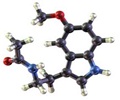Site of the brain responsible for sleep regulation has been identified in fruit flies.
Site of the brain responsible for sleep regulation has been identified in fruit flies. This area which was previously known for its role in learning and memory will help to further the study on sleep regulation and its role in memory. The research was conducted by scientists at the University of Pennsylvania School of Medicine.
Despite its importance in everyday human function, very little is known about the regulation of sleep. In search of the underlying brain region responsible for sleep regulation, senior author Amita Sehgal, PhD, Professor of Neuroscience and a Howard Hughes Medical Institute (HHMI) Investigator, and colleagues turned their attention to the fruit fly."Fruit flies and humans share similar resting patterns," explains Sehgal. "Like humans, the sleeping states of fruit flies are characterized by periods of immobility over a twenty-four hour period, during which the fruit flies demonstrate reduced responsiveness to sensory stimuli."
By tinkering with the gene expression of multiple regions of the fruit fly brain, the research team was able to zero in on the adult mushroom body as the sleep center of the brain. They reported their findings in last week's issue of Nature.
To locate the brain region involved in sleep regulation, Sehgal manipulated the activity of an enzyme known as protein kinase A (PKA). Previous work in Sehgal's lab revealed that the higher the level of PKA activity, the lower the period of immobility, or sleep, in the fruit fly. By building upon this work, Sehgal and others set out to increase PKA activity in various regions of the brain and examine the subsequent sleeping patterns in the fruit flies. "Sleeping fruit flies" were defined as those that remained immobile for at least five minutes.
"From the beginning, we took the unbiased approach," explains Sehgal. "We targeted PKA activity to different areas of the fly brain to find out where PKA acts to regulate sleep."
Sehgal was able to selectively turn on PKA activity in a variety of brain locations, which promoted PKA expression in designated regions. Of the different regions targeted, only two regions, both present in the adult mushroom bodies, led to changes in sleeping patterns of fruit flies. The fly mushroom body has been likened to the human hippocampus. The changes in sleep caused by the increased PKA activity in the adult mushroom bodies highlighted this region as the sleep-regulating region of the fruit fly brain.
Advertisement
"Although people typically think of mushroom bodies as possessing similar functions to the human hippocampus, the site where long-term memories are made, our lab tends to think of the mushroom bodies functioning more like the thalamus, the relay station through which most sensory input to the brain is targeted," explains Sehgal. "Previous research links the thalamus to a role in human sleep." (There is no human structure that is anatomically similar to the adult mushroom bodies of fruit flies.)
Advertisement
In a paper also published last week in Current Biology, Sehgal and colleagues showed that serotonin affects sleep in fruit flies by acting at the site of the adult mushroom bodies.
Sehgal's lab reduced the function of three types of serotonin receptors in the brains of fruit flies (5HT1A, 5HT1B, and 5HT2). The reduced 5HT1A receptor activity in the fruit flies led to fragmented and reduced overall sleep. In essence, the fruit flies tossed and turned in their sleep. But, the flies with reduced 5HT1B and 5HT2 receptor activity displayed no change in their sleeping pattern. Penn researchers were able to treat the fruit flies to a good night's sleep by administering serotonin to the adult mushroom bodies.
The finding that serotonin plays a role in increasing sleep in fruit flies offers hope for the future of therapeutics for sleep disorders. "Serotonin may also promote sleep in humans," suggests Sehgal. "This may explain why serotonin-increasing antidepressants increase sleep."
Future work by Sehgal's lab will attempt to look for a connection among sleep, serotonin, and learning, and memory, while looking deeper into the cellular and molecular activity that enables mushroom bodies to regulate sleep.
Source: Eurekalert











